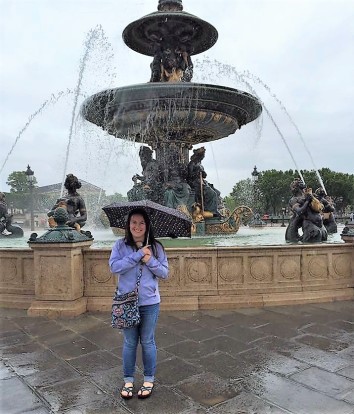
When many people imagine the French capital, trips to the Eiffel Tower, coffee in outdoor cafés, and strolls along the Seine are what typically come to mind. My Paris story is somewhat different. Though I definitely enjoy these aspects of Parisian life, I was not really a tourist during my two-week return to the city this May. Instead, I had the chance to be a researcher, doing archival work at the American Library in Paris (ALP).
The opportunity to conduct student research at such a prominent institution was both exciting and full of unknowns. Although I was in Paris as part of an amazing team (fellow student Michaela Stock and English professor Dr. Natalie Dykstra), I had limited archival experience prior to the project. It was a bit daunting as well to think that I, as a history and French undergraduate student, could contribute in any way to the largest English-language library in continental Europe. Once there, however, my apprehensions fell away. The Library welcomed us with open arms and we were soon up to our elbows in archive boxes and old books. I have always loved books, and I think my love of stories is one of the many factors that first drew me to history.
Archives have a beautiful way of telling stories. Comprising much more than simply books, their collections span decades, movements, and genres to paint a picture of the past that one letter, article, or picture cannot illustrate on its own. At a location like the ALP, which has been accumulating literature since its establishment in 1920, there are quite a lot of stories to be told. My research team and I explored just one of those through the personal collection and records of French composer and teacher Nadia Boulanger. The project gave me invaluable practice in handling archival materials and taught me that seemingly ordinary things can have historical value, too. It let me personally hold history in my hands. As a bonus, I even got to use my French!
It is sometimes easy to reduce the facts and timelines that historians study to impersonal accounts, rather than attribute them to the real people who actually lived them centuries, years, or minutes ago. Yet while photographing letters and transcribing inscriptions written to Boulanger, I also learned just how important it is to look at the lives behind the history. The remarkable things about her were not the number of years that she lived, or the number of books that she owned, but rather the number of people that she influenced in her lifetime. Boulanger was a loving friend and mentor to American and European musicians alike. It was impossible to tell her entire story in two weeks, but I am hopeful that the research and materials we assembled will help to preserve her legacy for generations to come.
To me, Paris itself is a living legacy as well. Nadia Boulanger and the archives of the ALP are just tiny pieces of that great story. I am so thankful to have had the time to dive into the city’s history, if only for two weeks. Everything has a story to tell, and we can all be storytellers.